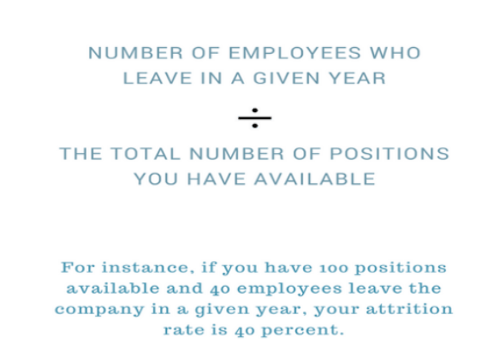
Attrition, turnover, and churn are words often used interchangeably. In HR terms, their use indicates the rate at which employees are voluntarily leaving your firm or business. Use this very simple calculation to determine what your annual attrition rate is:
(Number of employees who leave in a given year)
divided by
(The total number of positions you have available at your business)
equals
annual attrition rate

Let’s say that you calculate a turnover rate of 30%. That seems like a pretty high number, right? Or is it really? If your staff is comprised of a large number of high school students or college interns, 30% might be excellent turnover rate for you. If you are snowball stand owner, this number may be quite low.
The point is that instead of spending a copious amount of time trying to figure out if your churn rate is good or bad, based on its place on a numbers scale, you should be asking yourself what the implications of this rate mean for your company.
In other words, why are your staff members choosing to leave? Unless you can determine that some portion of your business operations is healthily turning over employees, any amount of turnover should make you stop and ask why this is happening.
According to our Senior Human Resources Manager Steffy Ritter, there are two main reasons why employees leave. The number one reason is due to a bad hiring. The second reason is bad management. Either way, she explains, “it is a waste of time and money when someone that you hire leaves your company.”
She suggests that you understand where you went wrong in your work process, and learn from it.
Bad Hiring
What bad hiring looks like:
“Someone who does not fit with your core values.
- They don’t fit with your culture.
- They can’t work well with others.
- They can’t do the job that you need them to.
- They can’t work your schedule.
But, you hired them anyway because you liked them for some reason.”
Lesson Learned:
“Sometimes, it is not clearly evident at first that a person is going be a bad hire. With multiple interviews, and multiple people attending each interview, you can drill down to see if someone will be a good fit or not for your company.”
Bad Management
What bad management looks like:
“Bad management does not have to mean screaming and yelling. It is also
- When people don’t feel valued
- You don’t give support or feedback that they need to get better
Lesson Learned:
“Managers have to be open to admitting that they are the reason that people have left, find ways to take ownership of it, and make changes to help them do a better job in the future.”
Key Points
In Steffy’s experience, turnover indicates that somewhere along the way, “someone didn’t make the right decisions.” She encourages that you investigate why as quickly as you see a problem developing.
Knowing that the two main reasons why employees leave are due to bad hiring or bad management, may help you determine a starting point for your inquiries.
Once you have drilled down to determine the root of the problem, it is just as important that you learn from the lessons to eliminate the same problems from popping up again in the future.




